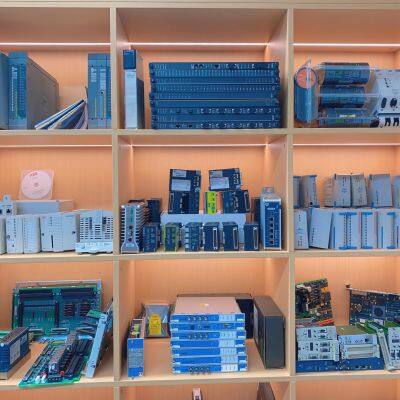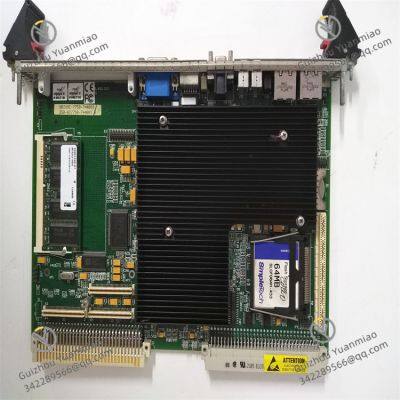Product Description
I. Overview
GE VMIVME - 7750 - 744001 350 - 027750 - 744001 F is a high-performance VMEbus single-board computer module, specially designed for industrial control systems. It was developed in the early 21st century and, although it has been discontinued, still plays a role in some industrial control applications due to its stable and reliable performance. Its design aims to provide solid hardware support for complex tasks such as industrial automation, process control, and data acquisition, and it holds an important position in the industrial field.

II. Technical Parameters
Processor performance: It is equipped with an Intel Pentium III processor, with a maximum main frequency of up to 1.26GHz. It has 32-bit addressing capability and a 64-bit data bus, adopts a superscalar architecture, and can execute three instructions per clock cycle. It can efficiently handle various complex operations, meeting the high requirements of industrial scenarios for real-time data processing and the operation of control algorithms.
Cache and memory: It is equipped with 512KB advanced transfer cache (L2 cache), which can reach the upper limit of this capacity in some configurations, providing high-bandwidth data access support for the processor. At the same time, it can accommodate 144-pin SDRAM SO - DIMM, with a maximum memory capacity of 512MB. It uses PC133 SDRAM and combines with the Intel 815e chipset to achieve a 133MHz system bus, ensuring fast data transmission and storage in the system.
Interface configuration: It has a variety of interface types. It integrates dual Ethernet controllers, supports 10BaseT and 100BaseTX network standards, and realizes network connection through two RJ45 connectors, facilitating the device to access industrial networks and realize data communication and remote control. In addition, it is equipped with two serial ports (RS - 232/RS - 422), which can be used to connect various serial devices such as sensors and intelligent instruments; one parallel port, which can meet specific parallel data transmission needs; a VMEbus interface, ensuring compatibility with VMEbus systems and facilitating system integration; and a IDE interface, which can be used to connect storage devices to expand data storage capacity.
Display function: It has a built-in AGP graphics adapter based on the 815e chipset, equipped with 4MB external synchronous DRAM cache and a high-bandwidth 64-bit data interface. It can support a screen resolution of up to 1600 x 1200 x 256 colors (single-view mode), which can provide operators with a clear graphical interface, meet the needs for multimedia-quality video display and high-resolution graphics display, and is suitable for industrial application scenarios that require visual monitoring and operation.
Power parameters: The working voltage is 220V, and the output frequency is 50kHz. It is designed to operate stably within a wide range of voltage and frequency, adapting to the power supply conditions in different industrial environments, and ensuring that the device can maintain optimal performance under various working conditions.

III. Functional Features
High-performance processing capability: The powerful Pentium III processor enables it to efficiently meet the real-time processing needs of a large amount of equipment status data and process parameter data in industrial automated production lines. For example, in automobile manufacturing automated production lines, it can quickly adjust the actions of robotic arms according to the data fed back by sensors, accurately control the assembly process of components, ensure the efficient and accurate execution of the production process, greatly improve production efficiency, and reduce the defective rate.
Strong environmental adaptability: It adopts a robust and durable design and can withstand harsh industrial environmental conditions. It can operate stably in high-temperature, low-temperature environments, as well as extreme working conditions such as strong vibration and high humidity. In the harsh high-temperature and dusty environment of steel smelters, or in complex field environments such as oil extraction, this module can continue to work normally, strongly ensuring the continuity of industrial production, greatly reducing the risk of equipment failure caused by environmental factors, and saving enterprises maintenance costs and losses caused by production interruption.
Convenient network communication: The features of dual Ethernet controllers and support for multiple network standards enable it to easily access various industrial networks. Through the Ethernet interface, it can not only be conveniently connected to the enterprise's internal network to realize data sharing and collaborative work between devices but also be conveniently connected to the cloud platform to realize functions such as remote monitoring, data upload and download. In smart factories, managers can obtain real-time information on the operating status of equipment through remote terminals, adjust and optimize the production process in a timely manner, and improve the intelligence level and response speed of enterprise production management.
Good system compatibility: It is strictly designed in accordance with the VMEbus standard and can seamlessly integrate with existing industrial systems. Whether it is the upgrading and transformation of old industrial control systems or the construction of a new industrial automation system, it can be well integrated into them, reducing compatibility problems in the system integration process, lowering development costs and time costs, and providing convenience for enterprises' technical upgrading and system updates.
Advantages of modular design: The modular design concept makes this module have significant advantages in maintenance and customization. When the module fails, it is easy to carry out fault detection and component replacement, and the normal operation of the equipment can be quickly restored. At the same time, according to the actual needs of specific projects, the module can be conveniently customized and configured, such as adding additional serial ports, replacing memory of different capacities, etc., to meet the needs of diversified industrial application scenarios and improve the versatility and flexibility of the equipment.

IV. Common Faults and Solutions
Network communication failure
Fault phenomenon: The network connection between the module and other devices is interrupted, data transmission cannot be performed, or packet loss, errors, etc. occur during data transmission.
Possible causes: Damaged network cables, such as broken outer skin of network cables and broken internal cables; loose RJ45 interfaces, leading to poor contact; incorrect network parameter settings, such as IP address conflict, improper subnet mask setting, etc.; hardware failure of the Ethernet controller.
Solutions: First, carefully check the network cable for obvious physical damage, and replace it with a new one if there is any; re-plug the RJ45 interface to ensure a firm connection; check and verify the network parameter settings to ensure that parameters such as IP address, subnet mask and gateway are correct and avoid conflicts with other devices; if the above checks are all correct but the fault still exists, it may be a hardware failure of the Ethernet controller, and professional maintenance personnel should be contacted for inspection and replacement.
Processor overheating failure
Fault phenomenon: During the operation of the equipment, the processor temperature is too high, resulting in slow system operation and even crash.
Possible causes: Failure of the cooling fan, such as damaged fan blades, stopped motor, etc., leading to ineffective heat dissipation; serious dust accumulation on the heat sink, hindering heat dissipation; the working environment temperature is too high, exceeding the normal heat dissipation capacity of the equipment.
Solutions: Check the cooling fan, and replace it with a new one in time if a fault is found; clean the dust on the heat sink, which can be carefully cleaned with a compressed air can or a brush to restore the heat dissipation performance of the heat sink; improve the working environment of the equipment, strengthen ventilation and heat dissipation measures, such as installing air conditioners and adding ventilation equipment, to reduce the ambient temperature and ensure that the processor operates within the normal temperature range.
Memory failure
Fault phenomenon: The system frequently has blue screens, crashes, or prompts memory errors during startup.
Possible causes: Loose memory module, poor contact; damaged memory chip; memory compatibility issues, such as using incompatible memory models or specifications.
Solutions: Open the equipment chassis, re-plug the memory module to ensure it is installed firmly; use professional memory detection tools to detect the memory, and if a damaged memory chip is found, replace the memory module with the same model and specification; if memory compatibility is suspected, refer to the equipment manual to confirm the supported memory models and specifications, and replace with compliant memory.
Interface failure
Fault phenomenon: After connecting devices to the serial port, parallel port or IDE interface, they cannot be recognized normally or data transmission is abnormal.
Possible causes: Loose interface, insecure connection; damaged interface circuit; driver not installed correctly or damaged.
Solutions: Check the interface connection, re-plug the device connection line to ensure a tight interface connection; if the interface circuit is damaged, professional maintenance personnel are required for repair or replacement of the interface board; for serial and parallel ports, check whether the driver in the device manager is normal, and if not, reinstall or update the driver; for the IDE interface, check whether the relevant settings in the BIOS are correct, and confirm whether the jumper settings of the hard disk and other devices match the connection mode.


IS220PPDAH1A Feedback board for power distribution system
IS200TREGH2B Gas turbine emergency trip terminal board
DS200PCCAG9ACB power supply and control card
VMIVME-2540-300 Intelligent Counter/Controller for VME Bus Architecture
IS200TRLYS1BGG Discrete I/O board
GE ACC-5595-208 350-805595-208 Reflective Memory Hub
GE VMIACC-5595-208 350-805595-208J Reflective Memory Hub
GE HWA143-TDM-PMC-V20 Input/Output Module
GE VG5SK8I052311 PM0N2000 Digital Input Module
VME bus single board computer MVME2305-900
GE RS-FS-9001 362A1052P404 Flame Sensor/Detector
MVME3100 VME bus single board computer
 yezi
Hi there! Welcome to my shop. Let me know if you have any questions.
yezi
Hi there! Welcome to my shop. Let me know if you have any questions.





